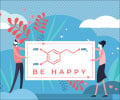American scientists have gained significant insights into the role that different levels of a brain chemical called dopamine play in Parkinson's disease and drug addiction.
American scientists have gained significant insights into the role that different levels of a brain chemical called dopamine play in Parkinson's disease and drug addiction.
D. James Surmeier, the Nathan Smith Davis Professor and chair of physiology at Northwestern University's Feinberg School of Medicine, says that a study has revealed that dopamine strengthens and weakens the two primary circuits in the brain that control behaviour.He says that this finding may help understand why a flood of dopamine can lead to compulsive, addictive behaviour, while too little of it can leave Parkinson's patients frozen and unable to move.
"The study shows how dopamine shapes the two main circuits of the brain that control how we choose to act and what happens in these disease states, " said Dr. Surmeier, lead author of the study published in the journal Science.
He has revealed that the two circuits are located in the striatum, the region of the brain that translates thoughts into actions.
Dr. Surmeier describes one of the circuits as a "stop" circuit that prevents an individual from acting on a desire, and the other as a "go" circuit that provokes him/her to action.
During the study, the strength of synapses connecting the cerebral cortex-the brain region involved in perceptions, feelings and thought-to the striatum were examined.
Advertisement
It caused the cortical synapses connecting to the "go" circuit to grow stronger and more powerful, and simultaneously weakened the cortical connections in the "stop" circuit, according to the researchers.
Advertisement
"All of our actions in a healthy brain are balanced by the urge to do something and the urge to stop. Our work suggests that it is not just the strengthening of the brain circuits helping select actions that is critical to dopamine's effects, it is the weakening of the connections that enable us to stop as well," he added.
In another experiment, the researchers created an animal model of Parkinson's disease by killing dopamine neurons, and looked at what would happen when they simulated cortical commands to move.
The connections in the "stop" circuit were strengthened, while those in the "go" circuit were weakened, said the researchers.
"The study illuminates why Parkinson's patients have trouble performing everyday tasks like reaching across a table to pick up a glass of water when they are thirsty," Dr. Surmeier said.
He added: "Our study suggests that the inability to move in Parkinson's disease is not a passive process like a car running out of gas. Rather, the car doesn't' move because your foot is jammed down on the brake. Dopamine normally helps you adjust the pressure on the brake and gas pedals. It helps you learn that when you see a red light at an intersection, you brake and when the green light comes on, you take your foot off the brake and depress the gas pedal to go. Parkinson's disease patients, who have lost the neurons that release dopamine, have their foot perpetually stuck on the brake."
The researcher says that understanding the basis for these changes in brain circuitry moves his team closer to new therapeutic strategies for controlling such brain disorders, as well as schizophrenia, Tourette's syndrome and dystonia.
Source-ANI
SRM













